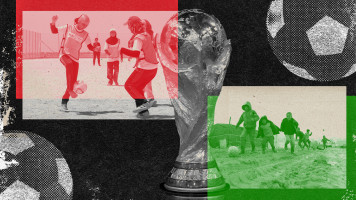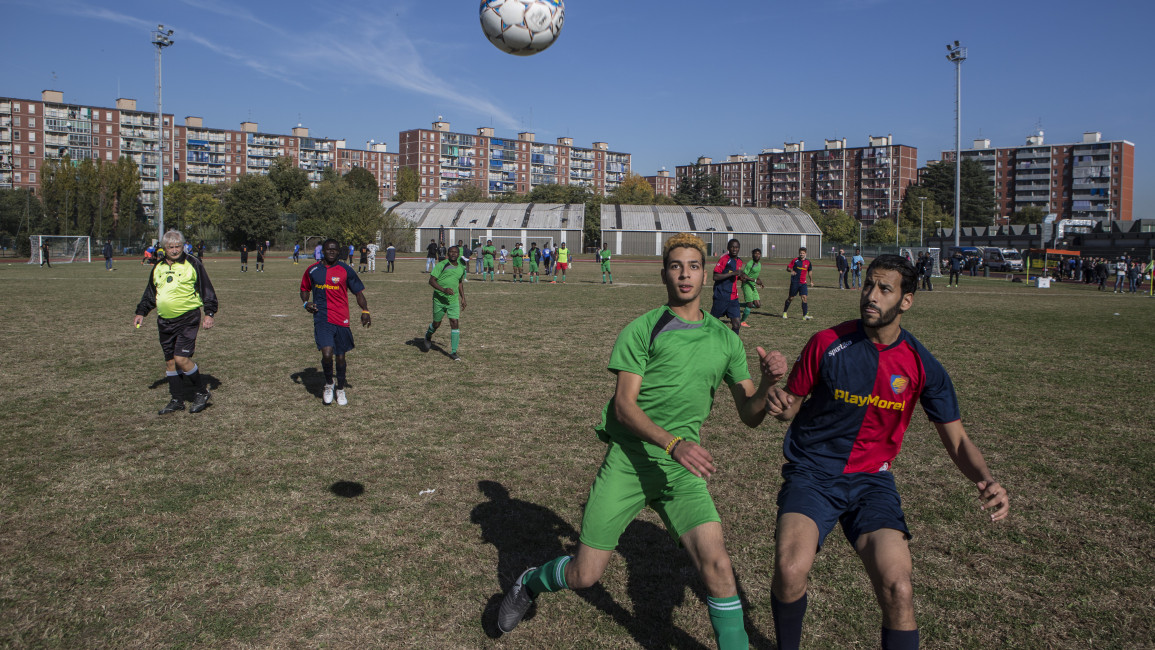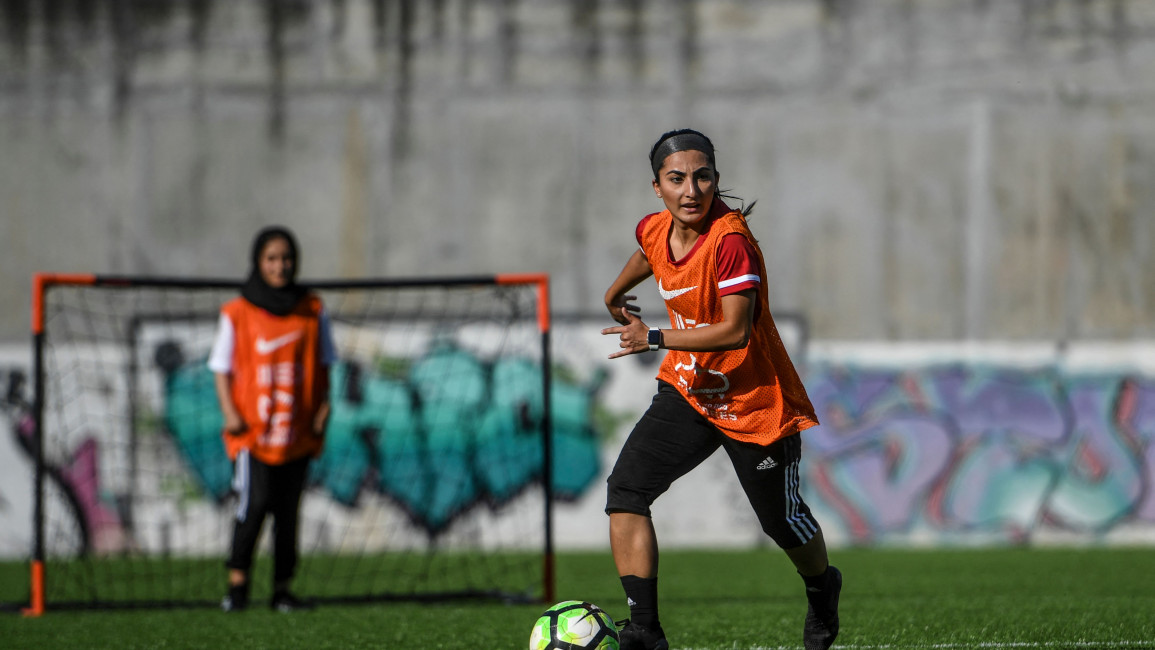
The power of football in refugee integration and development
In-depth7 min read
Ramón Spaaij
14 December, 2022
In-depth: Global attention may focus on the World Cup, but it is at the grassroots level that football can have the most meaningful impact, particularly in breaking down barriers for those who have experienced forced
displacement.
Amidst the ongoing human rights controversies surrounding the 2022 FIFA Men’s World Cup in Qatar a different kind of story emerged – one of hope, inspiration, and aspiration.
Twenty-seven-year-old Awer Mabil, a member of Australia’s national Socceroos squad, reflected on his own journey to the highest ranks of the beautiful game, hoping to create a new narrative around refugees and forced migration.
Mabil’s parents fled the civil war in South Sudan in 1994 and he was born in the Kakuma refugee camp in Kenya the following year. Mabil first learned to play football in Kakuma, where he and his friends would make footballs from plastic bags and balloons.
At the age of 10, Mabil and his family migrated to Australia. He told Australian news channel SBS how in the face of cultural differences and language barriers, he used football as a way of communicating with his peers in this new school. “Football was like a saviour for me and it was a way I could communicate,” he explained.
"For the vast majority of children and young people with refugee backgrounds, the power of football is felt less at the elite sport level and more in the everyday realities of grassroots sports activities"
Mabil’s journey attests to the power of football in the context of forced displacement and migration to help people build hopes and dreams for the future.
For the vast majority of children and young people with refugee backgrounds, the power of football is felt less at the elite sport level and more in the everyday realities of grassroots sports activities in which they participate – in refugee camps, 'kicking around' on the streets, in programs run by NGOs, at local community clubs, and so on.
Football and other sports appeal to many young people with refugee backgrounds as a form of recreation where they can experience a temporary escape from the strains of life and the traumas of their past, allowing them to enjoy the pleasures of play, develop their skills, and experience a sense of belonging.
Twenty-seven-year-old Awer Mabil, a member of Australia’s national Socceroos squad, reflected on his own journey to the highest ranks of the beautiful game, hoping to create a new narrative around refugees and forced migration.
Mabil’s parents fled the civil war in South Sudan in 1994 and he was born in the Kakuma refugee camp in Kenya the following year. Mabil first learned to play football in Kakuma, where he and his friends would make footballs from plastic bags and balloons.
At the age of 10, Mabil and his family migrated to Australia. He told Australian news channel SBS how in the face of cultural differences and language barriers, he used football as a way of communicating with his peers in this new school. “Football was like a saviour for me and it was a way I could communicate,” he explained.
"For the vast majority of children and young people with refugee backgrounds, the power of football is felt less at the elite sport level and more in the everyday realities of grassroots sports activities"
Mabil’s journey attests to the power of football in the context of forced displacement and migration to help people build hopes and dreams for the future.
For the vast majority of children and young people with refugee backgrounds, the power of football is felt less at the elite sport level and more in the everyday realities of grassroots sports activities in which they participate – in refugee camps, 'kicking around' on the streets, in programs run by NGOs, at local community clubs, and so on.
Football and other sports appeal to many young people with refugee backgrounds as a form of recreation where they can experience a temporary escape from the strains of life and the traumas of their past, allowing them to enjoy the pleasures of play, develop their skills, and experience a sense of belonging.
RELATEDIn-depthBasma El Atti
Breaking down barriers
Many young people who have experienced displacement are faced with several barriers to accessing opportunities to play, especially in organised sport, such as safety, cost, transport, and discrimination. South Sudanese Australian community leader and avid football player Deng explained the impact of these barriers and the importance of widening access to football.
“It’s a lack of opportunity, but also it’s a lack of I guess someone giving them that opportunity to start in the grassroots and evolve it, take it step by step, slowly. Because at the end of the day what will make the difference is creating a safe environment, making links with the families, getting their trust, their respect, that will make the difference,” he said.
“You can have a hundred girls who want to play in your club, but if they don’t feel safe, their parents don’t know you and they’re not allowed to take risks, then they’re not going to stay there.”
Many community-based programs around the world, often referred to as ‘sport for development’, work tirelessly to address these barriers. Public and private actors that support such programs include football federations, professional football clubs, local and transnational NGOs, government agencies, philanthropic entities, multinational corporations, and individual (former) players.

Some 150 refugees, mostly from Sub-Saharan African countries, took part in the first friendly football tournament between teams composed of asylum seekers in Italy on 24 October 2017. [Getty]
The objectives of these initiatives often go beyond access to and participation in sport to address wider social, health, and educational goals, such as health education, entrepreneurship, conflict transformation, and women’s rights.
In such programs, sports activities are principally a hook or educational context for working with young people, rather than simply an end in themselves. This is often referred to as ‘plus sport’, in which sport’s perceived ability to engage marginalised young people is part of a broader, holistic youth development approach supported by a range of interconnected activities.
Spirit of Soccer, whose slogan is “Football saves children’s lives”, exemplifies this “plus sport” model. It operates in conflict and post-conflict zones, and among its many activities, the organisation delivers clinics in schools, communities, and refugee camps in Jordan, Iraq, and Lebanon to educate people about the dangers of landmines and Explosive Remnants of War, wrapping safety messages into football games and drills.
"Sport activities are principally a hook or educational context for working with young people, rather than simply an end in themselves"
Improving access to football for girls and young women
Historically girls and women have had fewer opportunities to participate in football, and football for development is no exception. Girls and young women with refugee backgrounds often face amplified barriers to participation, for example, a lack of culturally appropriate facilities, safety concerns, cost, and family and caring responsibilities.
There may exist a perception within their family or community that playing football is inappropriate for women, especially in the presence of men. Owing to the ongoing efforts of community activists like Deng, who tries to gradually build trust and transform gender norms in his community, there are now increased opportunities for girls and women to be involved in football.
Several 'sport for development' programs work specifically towards improving access to sports for girls and young women by creating female-friendly environments. The Sport for Protection Toolkit, developed by the United National High Commissioner for Refugees, International Olympic Committee, and Terre des Hommes organisation, documents practical strategies to increase girls’ engagement in sport, such as providing culturally-appropriate sports uniforms and women-only playing spaces, training female coaches, and increasing family buy-in and trust by actively engaging them in the process.
For example, World Vision’s football program in the Azraq refugee camp in Jordan actively trains female coaches to make parents feel more comfortable about letting their daughters play and to create “role models” for the participating girls.
The objectives of these initiatives often go beyond access to and participation in sport to address wider social, health, and educational goals, such as health education, entrepreneurship, conflict transformation, and women’s rights.
In such programs, sports activities are principally a hook or educational context for working with young people, rather than simply an end in themselves. This is often referred to as ‘plus sport’, in which sport’s perceived ability to engage marginalised young people is part of a broader, holistic youth development approach supported by a range of interconnected activities.
Spirit of Soccer, whose slogan is “Football saves children’s lives”, exemplifies this “plus sport” model. It operates in conflict and post-conflict zones, and among its many activities, the organisation delivers clinics in schools, communities, and refugee camps in Jordan, Iraq, and Lebanon to educate people about the dangers of landmines and Explosive Remnants of War, wrapping safety messages into football games and drills.
"Sport activities are principally a hook or educational context for working with young people, rather than simply an end in themselves"
Improving access to football for girls and young women
Historically girls and women have had fewer opportunities to participate in football, and football for development is no exception. Girls and young women with refugee backgrounds often face amplified barriers to participation, for example, a lack of culturally appropriate facilities, safety concerns, cost, and family and caring responsibilities.
There may exist a perception within their family or community that playing football is inappropriate for women, especially in the presence of men. Owing to the ongoing efforts of community activists like Deng, who tries to gradually build trust and transform gender norms in his community, there are now increased opportunities for girls and women to be involved in football.
Several 'sport for development' programs work specifically towards improving access to sports for girls and young women by creating female-friendly environments. The Sport for Protection Toolkit, developed by the United National High Commissioner for Refugees, International Olympic Committee, and Terre des Hommes organisation, documents practical strategies to increase girls’ engagement in sport, such as providing culturally-appropriate sports uniforms and women-only playing spaces, training female coaches, and increasing family buy-in and trust by actively engaging them in the process.
For example, World Vision’s football program in the Azraq refugee camp in Jordan actively trains female coaches to make parents feel more comfortable about letting their daughters play and to create “role models” for the participating girls.
RELATEDIn-depthJohn Duerden
The limits of 'football for development'
There are many proven social, health, and educational benefits associated with young people with refugee backgrounds participating in sports. However, football for development is not a panacea for addressing the precarious political, legal, and socioeconomic conditions that many refugees face.
Football for development programs tend to operate within a discourse of individual empowerment. They give participants opportunities to increase their confidence, skills, self-efficacy, and self-responsibility, but often without addressing the structural inequalities and power relations that shape refugees’ marginalisation.
Refugees commonly experience a denial of rights and politics of deterrence that, a recent study shows, manifest themselves in various ways including being denied the right to play in local football clubs and opportunities for playing with local residents being curtailed.

Players of Afghanistan's national women's football team, who were forced to flee after the Taliban came to power, attend a training session in Lisbon, Portugal on 30 September 2021. [Getty]
These forms of exclusion appear to be at odds with FIFA’s self-proclaimed commitment to promoting an inclusive global football community that treats everyone equally.
In most cases, the opportunities that sports programs afford to young people with refugee backgrounds primarily constitute moments of inclusion and belonging or a temporary safe space. They may enable refugees to survive and adapt as individuals within existing conditions, rather than work to challenge and alter those conditions.
It is therefore important not to romanticise or uncritically preach the “power of sport” for refugees. Instead, it is important to consider both its value and its limitations. Any lived experiences and outcomes are also highly contextual; there is no such thing as a single, unitary “refugee experience” in sport or society.
At the same time, there is the risk of framing the achievements of elite athletes like Awer Mabil only in terms of their (former) refugee status and the challenging circumstances that they endured.
"Football for development is not a panacea for addressing the precarious political, legal, and socioeconomic conditions that many refugees face"
Whilst the challenges that refugees face are real, their achievements should not be framed merely in relation to those labels. A strengths-based approach that recognises the capabilities, resilience, and talents of young people with refugee backgrounds is far more helpful.
There is a lot to learn from their journeys in football – not just at the elite level but, like Deng, at the everyday level of recreational football too. Mabil emphasises that it is important not to define refugees by their title or as “someone to feel sorry for”, but as a person with a strong mentality, values, and aspirations.
The FIFA World Cup provides a highly visible stage for some of these strengths, talents, and achievements to be displayed and celebrated. But despite all the focus on the World Cup, ultimately it is grassroots sport that deserves the attention and resources to support participation and social development in a meaningful and sustainable way.
Ramón Spaaij, PhD, is professor of sociology at the Institute for Health and Sport at Victoria University in Melbourne, Australia. He is a sociologist of sport, with a speciality in the intersections of sport, social inclusion, conflict, and development.
This piece is based on 'Refugees and Football in the Global and Middle East Context' in Football in the Middle East: State, Society, and the Beautiful Game (2022).
These forms of exclusion appear to be at odds with FIFA’s self-proclaimed commitment to promoting an inclusive global football community that treats everyone equally.
In most cases, the opportunities that sports programs afford to young people with refugee backgrounds primarily constitute moments of inclusion and belonging or a temporary safe space. They may enable refugees to survive and adapt as individuals within existing conditions, rather than work to challenge and alter those conditions.
It is therefore important not to romanticise or uncritically preach the “power of sport” for refugees. Instead, it is important to consider both its value and its limitations. Any lived experiences and outcomes are also highly contextual; there is no such thing as a single, unitary “refugee experience” in sport or society.
At the same time, there is the risk of framing the achievements of elite athletes like Awer Mabil only in terms of their (former) refugee status and the challenging circumstances that they endured.
"Football for development is not a panacea for addressing the precarious political, legal, and socioeconomic conditions that many refugees face"
Whilst the challenges that refugees face are real, their achievements should not be framed merely in relation to those labels. A strengths-based approach that recognises the capabilities, resilience, and talents of young people with refugee backgrounds is far more helpful.
There is a lot to learn from their journeys in football – not just at the elite level but, like Deng, at the everyday level of recreational football too. Mabil emphasises that it is important not to define refugees by their title or as “someone to feel sorry for”, but as a person with a strong mentality, values, and aspirations.
The FIFA World Cup provides a highly visible stage for some of these strengths, talents, and achievements to be displayed and celebrated. But despite all the focus on the World Cup, ultimately it is grassroots sport that deserves the attention and resources to support participation and social development in a meaningful and sustainable way.
Ramón Spaaij, PhD, is professor of sociology at the Institute for Health and Sport at Victoria University in Melbourne, Australia. He is a sociologist of sport, with a speciality in the intersections of sport, social inclusion, conflict, and development.
This piece is based on 'Refugees and Football in the Global and Middle East Context' in Football in the Middle East: State, Society, and the Beautiful Game (2022).
No comments:
Post a Comment